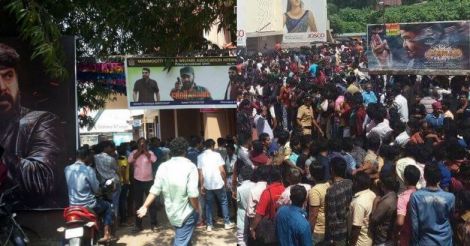Film-lovers in Kerala have been baffled by claims of movies breaking first day collection records, hitting Rs 20 crore gross, making it into the Rs 100 crore club and so on. “What do these claims mean and how much truth does it hold?” ask even diehard fans of the super and mega stars.
What are the essentials of calculating film collection?
Suppose, a film-goer buys a ticket for Rs 100; Rs 2 out of that goes as service tax and Rs 3 as cess. The rest, Rs 95, is the gross collection. Cinema houses in municipal areas pay 20 percent tax and the money left after that is the net collection. The taxes vary according to the location of the theater. Cinema houses in a corporation pay more tax than ones in municipalities and panchayats.
The film distributor gets a 60 percent share in the first week and 55 percent in the second week. Beyond that, till the movie gets held over, the share will be 50 percent. Once the film is held over, his share dips to 40 percent. Rest of the business is based on a deal between the producer and the distributor.
To cut these hassles and to increase profit ratio, these days, some of the producers take up the responsibility of distributing their movies.
Pulimurugan – the trend setter
Pulimurugan, with Mohanlal in the lead, mopped up Rs 90 crore from Kerala itself. However, the producer would have got only one-third from this money. For example, if the gross had been Rs 70 crore, the producer's share would be Rs 35 crore after the deductions. The film was distributed by Tomichan Mulakuppadam, the producer himself. Pulimurugan rewrote the opening day records of Mollywood, all thanks to increased number of shows on the release day – several screens ran up to six shows.
Films like Pulimurugan and Mammootty-starrer The Great Father highlight the fact that they draw people, who have been spending their time on television serials, to the theaters. Similar trend was seen years ago when films like Meesha Madhavan, Thenkashi Pattanam and Pulivaal Kalyanam were released. That kind of festivity had declined as popularity of television channels increased and cell phones penetrated the market.
An estimated 25 lakh watched Oru Vadakkan Selfie in theaters. Out of the 3 crore population of the state, Pulimurugan drew 75 lakh to theaters. Online reservation has also contributed in wooing people back to movie houses. Many families are ready to visit theaters, with children, if they are offered good facilities and security.
Classmates, the campus movie released in year 2006, collected Rs 18 crore then. Many feel, it would have entered the Rs 100 crore club if it was released today. Out of the Rs 18 crore collection, the producer got a profit of just Rs 6.5 crore. Those were days when tickets were available for a maximum of Rs 50. Besides, there were no multiplexes in those days.
Better cinema experience
Kerala still has theaters with thatched roof and no air condition. Experience has shown that collection is directly proportional to the quality of theaters. Theaters are indeed a solid business, provided more money is invested to improve facilities like projection and sound system. A new breed of owners are pumping money into their cinema houses and that's one of the reasons why Malayalam cinema is seeing big budget projects beyond its dreams.

























